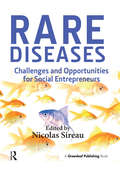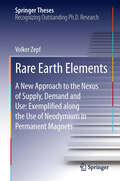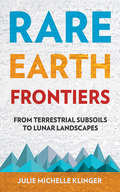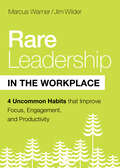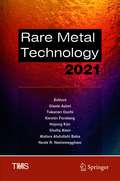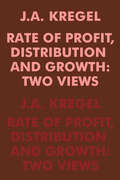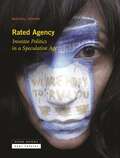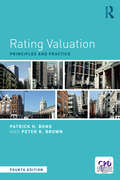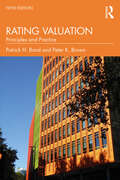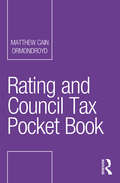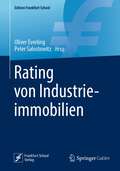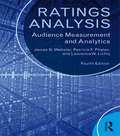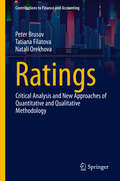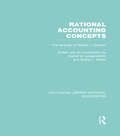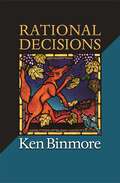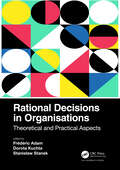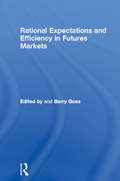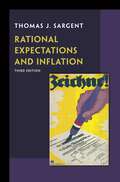- Table View
- List View
Rare Diseases: Challenges and Opportunities for Social Entrepreneurs
by Nicolas SireauThere are 7,000 rare diseases affecting 6%–8% of the global population. That's 3.5 million people in the UK alone. Yet only 200 rare diseases have approved treatments. In recent years, there has been a surge of interest from business and social entrepreneurs in the field of health – including looking at ways to treat rare disease patients better and faster. This book presents some of the latest developments in the world of rare disease entrepreneurship from a global group of experts. It examines the topic from the business angle, considering the drug development process and providing case studies of successful orphan drug enterprises. It also looks at rare diseases from the perspective of the patient, analysing the growing rare disease patient movement, a successful patient group that uses social enterprise techniques, and chapters on key requirements for helping patients with rare diseases through registries and centres of excellence. The book will be an essential toolkit for social and business entrepreneurs who are interested in the world of rare/orphan diseases. It has the rigour of an academic publication, along with the clarity of a lay publication. An original and timely book, Rare Diseases will help to add knowledge and awareness to a vastly under-published subject.
Rare Earth Elements
by Volker ZepfThis thesis deals with Rare Earth Elements (REE), especially with neodymium used in permanent magnets, from a very scientific basis by providing basic research data. Despite the fact that REE are newsworthy and very important elements for a considerable bandwidth of todays' technologies, accompanied by the monopolistic supply-situation and Chinese politics, there are inexplicable data discrepancies about REE which have been recognized frequently but usually have not been addressed accordingly. So this analysis started with the hypothesis that the four application areas, namely computer hard disk drives (HDD), mobile phones, wind turbines and e-mobility (automotive traction), account for about 80% of the global annual neodymium-demand. The research methodology was a laboratory analysis of the composition of used magnets for HDDs and mobile phones and a literature and official report analysis of wind turbine and automotive neodymium use. The result was amazing and the hypothesis had to be withdrawn as these four areas only account for about 20% of neodymium use. This result raises some questions concerning actual use and thus potential recycling options.
Rare Earth Frontiers: From Terrestrial Subsoils to Lunar Landscapes
by Julie Michelle KlingerRare Earth Frontiers is a work of human geography that serves to demystify the powerful elements that make possible the miniaturization of electronics, green energy and medical technologies, and essential telecommunications and defense systems. Julie Michelle Klinger draws attention to the fact that the rare earths we rely on most are as common as copper or lead, and this means the implications of their extraction are global. Klinger excavates the rich historical origins and ongoing ramifications of the quest to mine rare earths in ever more impossible places.Klinger writes about the devastating damage to lives and the environment caused by the exploitation of rare earths. She demonstrates in human terms how scarcity myths have been conscripted into diverse geopolitical campaigns that use rare earth mining as a pretext to capture spaces that have historically fallen beyond the grasp of centralized power. These include legally and logistically forbidding locations in the Amazon, Greenland, and Afghanistan, and on the Moon. Drawing on ethnographic, archival, and interview data gathered in local languages and offering possible solutions to the problems it documents, this book examines the production of the rare earth frontier as a place, a concept, and a zone of contestation, sacrifice, and transformation.
Rare Leadership in the Workplace: Four Habits that Improve Focus, Engagement, and Productivity
by Marcus Warner Jim WilderRevive your leadership. Grow healthy teams. See great results.Healthy teams begin with healthy leaders, and at the heart of this dynamic is emotional maturity—the quality the greatest leaders possess.Combining cutting-edge brain science with decades of counseling and consulting experience, Rare Leadership in the Workplace shows you how to take your leadership and your team to the next level. It will equip you to:Cultivate emotional maturity in yourself and othersDevelop the four habits of R.A.R.E. leadersPromote a strong group identityKeep relationships bigger than problemsIncrease productivity through trust, joy, and engagementWhether you are burnt out or just looking to improve, this book can help. When you prioritize people and lead from a secure identity, you&’ll be amazed at the freedom you feel and the results you see. You can lead from a healthy place, respond rather than react, and build the team of your dreams.If you want to take your organization to the next level, it starts with you. Read Rare Leadership in the Workplace and be equipped to lead enthusiastic, emotionally mature, relationally connected teams.
Rare Leadership in the Workplace: Four Habits that Improve Focus, Engagement, and Productivity
by Marcus Warner Jim WilderRevive your leadership. Grow healthy teams. See great results.Healthy teams begin with healthy leaders, and at the heart of this dynamic is emotional maturity—the quality the greatest leaders possess.Combining cutting-edge brain science with decades of counseling and consulting experience, Rare Leadership in the Workplace shows you how to take your leadership and your team to the next level. It will equip you to:Cultivate emotional maturity in yourself and othersDevelop the four habits of R.A.R.E. leadersPromote a strong group identityKeep relationships bigger than problemsIncrease productivity through trust, joy, and engagementWhether you are burnt out or just looking to improve, this book can help. When you prioritize people and lead from a secure identity, you&’ll be amazed at the freedom you feel and the results you see. You can lead from a healthy place, respond rather than react, and build the team of your dreams.If you want to take your organization to the next level, it starts with you. Read Rare Leadership in the Workplace and be equipped to lead enthusiastic, emotionally mature, relationally connected teams.
Rare Metal Technology 2021 (The Minerals, Metals & Materials Series)
by Neale R. Neelameggham Hojong Kim Shafiq Alam Takanari Ouchi Gisele Azimi Alafara Abdullahi Baba Kerstin ForsbergThis collection presents papers from a symposium on extraction of rare metals as well as rare extraction processing techniques used in metal production. It covers metals essential for critical modern technologies including electronics, electric motors, generators, energy storage systems, and specialty alloys. Rare metals are the main building blocks of many emerging critical technologies and have been receiving significant attention in recent years. Much research in academia and industry is devoted to finding novel techniques to extract critical and rare metals from primary and secondary sources. The technologies that rely on critical metals are dominating the world, and finding a way to extract and supply them effectively is highly desirable and beneficial. Rapid development of these technologies entails fast advancement of the resource and processing industry for their building materials. Authors from academia and industry exchange knowledge on developing, operating, and advancing extractive and processing technologies. Contributions cover rare-earth elements (magnets, catalysts, phosphors, and others), energy storage materials (lithium, cobalt, vanadium, graphite), alloy elements (scandium, niobium, titanium), and materials for electronics (gallium, germanium, indium, gold, silver). The contributions also cover various processing techniques in mineral beneficiation, hydrometallurgy, separation and purification, pyrometallurgy, electrometallurgy, supercritical fluid extraction, and recycling (batteries, magnets, electrical and electronic equipment).
Rate of Profit, Distribution and Growth: Two Views
by J.A. KregelA controversy among economists has raged in the pages of professional journals for the last decade. The debate concerns capital theory and distribution theory, as well as interpretation of models of long-run economic growth. This book is an attempt to integrate recent developments in capital theory and show their implications for models of long-run economic growth in mature capitalistic countries.This book first presents the von Neumann model and outlines its classical approach to the rate of profits and distribution. Sraffa's resolution of the value-price transformation problem is then presented and compared with Samuelson's ""Surrogate Production Function"". With the results of this comparison and the delineation of the special case in which the ""Surrogate"" is valid, several existing models of growth are set out in two representative groups.Neoclassical models form the first group. These are defined by their reliance on marginal theory to determine factor prices, the rate of profit and therefore distribution via the perfectly differentiable production function. Models of Meade, Tobin, Solow, and Samuelson- Modigliani are outlined and analyzed for their treatment and distribution and profits theory. The second group is comprised of models within the strict Keynesian tradition. The basic groundwork of these models as found in the work of Keynes and Kalecki is first cited. The Keynesian models are characterized by their assumption that the investment decision is totally independent of savings decisions in the economy. The models of Harrod, Kaldor, Pasinetti and Joan Robinson are presented and their method of approach to the rate of profits and distribution is analyzed.The concluding chapter focuses on some criticisms brought against the Keynesian models and offers some generalized formulations to deal with these neoclassical objections. General conclusions follow the treatment of each representative group and author.
Rated Agency: Investee Politics in a Speculative Age
by Michel FeherThe hegemony of finance compels a new orientation for everyone and everything: companies care more about the moods of their shareholders than about longstanding commercial success; governments subordinate citizen welfare to appeasing creditors; and individuals are concerned less with immediate income from labor than appreciation of their capital goods, skills, connections, and reputations.That firms, states, and people depend more on their ratings than on the product of their activities also changes how capitalism is resisted. For activists, the focus of grievances shifts from the extraction of profit to the conditions under which financial institutions allocate credit. While the exploitation of employees by their employers has hardly been curbed, the power of investors to select investees — to decide who and what is deemed creditworthy — has become a new site of social struggle.In clear and compelling prose, Michel Feher explains the extraordinary shift in conduct and orientation generated by financialization. Above all, he articulates the new political resistances and aspirations that investees draw from their rated agency.
Ratgeber für Arbeitnehmererfinder: Rechte und Pflichten des erfinderischen Arbeitnehmers
by Thomas Heinz MeitingerUngefähr 80% der Erfindungen in Deutschland stammen von Arbeitnehmern. Für diese Gruppe von Erfindern ist das Gesetz über Arbeitnehmererfindungen einschlägig. Das Gesetz klärt die Kollision des Patentgesetzes mit dem Arbeitsrecht. Das Patentgesetz bestimmt, dass der Erfinder der alleinige Eigentümer seiner Erfindung ist. Im Gegensatz dazu ordnet das Arbeitsrecht ein Arbeitsergebnis, also auch eine Erfindung eines Arbeitnehmers, dem Eigentum des Arbeitgebers zu. Der erfinderische Arbeitnehmer, der zumeist eine technische Tätigkeit ausübt, sieht sich unvermittelt mit rechtlichen Fragestellungen konfrontiert. Sein Gegenüber ist ein Patentanwalt, der ein Angestellter seines Unternehmens ist oder der von seinem Unternehmen beauftragt wurde. Der „Gegenspieler“ des erfinderischen Arbeitnehmers ist daher juristisch versiert. Waffengleichheit im Gespräch des erfinderischen Arbeitnehmers mit den Vertretern des Arbeitgebers besteht nicht. Dieses Fachbuch gibt dem Arbeitnehmer das rechtliche Know-How, um seine Interessen erfolgreich zu verfolgen. Der Arbeitgeber wird es in aller Regel begrüßen, dass sein Arbeitnehmer Sachkompetenz erwirbt. Hierdurch wird zumeist eine schnelle Einigung der Parteien ermöglicht und dadurch der Arbeitsfrieden bewahrt.
Rating Valuation: Principles and Practice
by Patrick H. Bond Peter K. BrownRating Valuation: Principles and Practice has long been the standard go-to guide for both students studying rating valuation and practitioners needing a comprehensive reference book covering rating law, valuation and, importantly, practice. This fourth edition brings the reader up to date with the changes for the 2017 Rating Revaluation, including the new Check, Challenge and Appeal procedures, and developments in case law, as well as highlights the differences between the law in England and Wales. A comprehensive chapter on Northern Ireland rating has been added to this edition. Starting with the basics, the book goes on to provide more in-depth detail for advanced readers, using clear, accessible and engaging analysis and example valuations throughout to break down what many see as a complex subject. Whether you are studying to pass your APC, or just want an overview of the changes taken in by the latest revaluation, Rating Valuation: Principles and Practice will give you all you need to understand rating valuation.
Rating Valuation: Principles and Practice
by Patrick H. Bond Peter K. BrownRating Valuation: Principles and Practice has long been the standard go-to guide for both students studying rating valuation and practitioners needing a comprehensive reference book covering rating law, valuation and, importantly, practice. This fifth edition brings the reader up to date with the changes for the 2023 Rating Revaluation and developments in case law, as well as highlighting the differences between the law in England and Wales. A comprehensive chapter covers rates in Northern Ireland. Starting with the basics, the book goes on to provide more in-depth detail for advanced readers, using clear, accessible and engaging analysis and example valuations throughout to break down what many see as a complex subject. Whether you are studying to pass your APC, or just want an overview of the changes following the latest revaluation, Rating Valuation: Principles and Practice will give you all you need to understand rating valuation.
Rating and Council Tax Pocket Book (Routledge Pocket Books)
by Matthew Cain OrmondroydThe Rating and Council Tax Pocket Book is a concise, practical guide to the legal and practical issues surrounding non-domestic rates and council tax. An essential tool for busy tax collection practitioners in local authorities and private practice, it will also be suitable for a range of non-specialist property professionals who may have to deal with rates and council tax matters as part of their practice. This handy pocket guide is accessible to specialist and non-specialist alike, covering everything from key concepts through to liability, exemptions, procedure and completion notices. The book encompasses both English and Welsh law, and includes all the relevant statutory provisions. With detailed discussion of key cases, this is a book that no one with an interest in rating and council tax should be without.
Rating von Industrieimmobilien (Edition Frankfurt School)
by Oliver Everling Peter SalostowitzDieses Buch stellt Perspektiven, Beurteilungsansätze, Voraussetzungen, Prozesse, Anforderungen und Erwartungen nicht nur der Leserzielgruppe in der Immobilienbranche, sondern darüber hinaus interessierten Lesern aus Wissenschaft und Praxis fundiert und facettenreich vor. Das Werk trägt dazu bei, einen strukturierten Überblick über die Möglichkeiten zu liefern, die aktuellen Herausforderungen in der Logistik und im Management von Industrieimmobilien anzunehmen.Große Miet- und Kaufpreissteigerungen bei Industrieimmobilien zeugen von einer Marktdynamik, die Investoren, Banken und Führungskräfte der Logistikbranche vor neue Herausforderungen stellen. Die große Nachfrage von Investoren nach marktfähigen Industrieimmobilien lässt Mietrenditen fallen und treibt zugleich die Mieterhöhungen. Der Druck auf Entscheidungsträger wächst aber nicht nur durch die geldpolitischen und gesamtwirtschaftlichen Rahmenbedingungen, sondern auch durch spezifische Megatrends, die speziell die Logistik und Industrieimmobilien betreffen: Welche Konsequenzen sind aus E-Commerce, 3D-Druck, Elektromobilität und Robotik zu ziehen? Was ist eine zukunftsfähige Industrieimmobilie, wenn bspw. keine Teilelager mehr für die Automobilindustrie und überhaupt weniger Bauteile wegen des Endes des Verbrennungsmotors gebraucht werden? Wenn Auslieferungszeiten auf eine Stunde sinken sollen, kann eine solche Anforderung nur noch aus kundennahen Immobilien darstellbar sein? Gibt es demnächst andere Hallentypen bzw. benotigt man für die Versorgung der Innenstädte überhaupt noch Hallen und wenn ja, wieviele Geschosse werden diese bei steigenden Grundstückspreisen in Zentrumsnähe haben? Werden Kunden steigende Versandkosten tragen oder dreht sich mit der Last der Auslieferungskosten der Trend zu kürzeren Auslieferungszeiten wieder um? Was passiert mit den bisher präferierten Mega-Hallen? Was spricht für mehrgeschossige Hallen an den Knotenpunkten der Infrastruktur unter Berücksichtigung von Personal und technischer Gebäudeausstattung? Hält der Trend zur Urbanisierung an oder wird die Bevölkerung aufgrund der Möglichkeiten von Homeoffice und Videokonferenzen wieder verstärkt „aufs Land“ ziehen? Wenn ja, sind die jetzigen Hallen dann noch richtig platziert? Funktionieren oder rechnen sich dann überhaupt noch Konzepte wie z.B. Lebensmittelonlinehandel? Die Autoren des Buches diskutieren Antworten auf solche und weitere Fragen aus Expertensicht. Zielgruppe sind alle, die in der Praxis mit dem Management, der Investition und Finanzierung von Logistikimmobilien zu tun haben. Indem der Titel an den Gedanken des Ratings anknüpft, Alternativen zu erheben, zu vergleichen und zu klassifizieren, soll dem Leser ein Herausgeberwerk geboten werden, das zwar wissenschaftlich fundiert ist, aber eher als praxisorientiertes Kompendium mit konkretem Nutzen für die Betroffenen positioniert ist.
Ratings Analysis: Audience Measurement and Analytics
by James Webster Patricia Phalen Lawrence LichtyThis 4th edition of Ratings Analysis describes and explains the current audience information system that supports economic exchange in both traditional and evolving electronic media markets. Responding to the major changes in electronic media distribution and audience research in recent years, Ratings Analysis provides a thoroughly updated presentation of the ratings industry and analysis processes. It serves as a practical guide for conducting audience research, offering readers the tools for becoming informed and discriminating consumers of audience information. This updated edition covers: International markets, reflecting the growth in audience research businesses with the expansion of advertising into new markets such as China. Emerging technologies, reflecting the ever increasing ways to deliver advertising electronically and through new channels (social media, Hulu) Illustrates applications of audience research in advertising, programming, financial analysis, and social policy; Describes audience research data and summarizes the history of audience measurement, the research methods most often used, and the kinds of ratings research products currently available; and Discusses the analysis of audience data by offering a framework within which to understand mass media audiences and by focusing specifically to the analysis of ratings data. Appropriate for all readers needing an in-depth understanding of audience research, including those working in advertising, electronic media, and related industries, Ratings Analysis also has much to offer academics and policy makers as well as students of mass media.
Ratings als Steuerungsinstrument von Unternehmen für eine nachhaltige Entwicklung
by Christian StrangaliesIn diesem Open-Access-Buch wird mit Hilfe einer systemtheoretischen Perspektive untersucht, wie Nachhaltigkeitsratings zu einer sinnvollen Gesellschaft beitragen. In einer grundlegenden Einführung in die Systemtheorie wird erklärt, wie die Selbsterhaltung von sozialen Systemen durch neuen Sinn ermöglicht wird, der auf weiteren Sinn verweist. Daraufhin wird die Notwendigkeit einer nachhaltigen Entwicklung der Gesellschaft systemtheoretisch dargestellt, indem ein pathologisches Wirtschaftssystem beschrieben wird, das die eigene Umwelt zerstört und dadurch immer weniger sinnvolle Anschlussoperationen findet, die weiteren Sinn ermöglichen. Zudem wird erläutert, wie aus systemtheoretischer Sicht ein nachhaltiges Wirtschaftssystem operiert. Es wird ausgeführt, wie durch eine begrenzte Reflexion neuer Sinn für das Wirtschaftssystem erzeugt wird, der im Einklang steht mit den gesellschaftlichen Entwicklungsmöglichkeiten und somit die wirtschaftliche und gesellschaftliche Selbsterhaltung langfristig sicherstellt. Anhand von Nachhaltigkeitsratings wird dann ein konkretes Beispiel angeführt, wie Entscheidungen mit einer begrenzten Reflexion in Unternehmen zu einer solchen sinnvollen Ökonomie beitragen.
Ratings: Critical Analysis and New Approaches of Quantitative and Qualitative Methodology (Contributions to Finance and Accounting)
by Peter Brusov Tatiana Filatova Natali OrekhovaThis book presents new methodologies for rating non-financial issuers and project ratings based on the BFO (Brusov-Filatova-Orekhova) theory of capital cost and structure, and its perpetuity limit (Modigliani-Miller theory), as well as modern investment models created by the authors. It first provides a critical analysis of the methodological and systemic shortcomings of the current credit ratings of non-financial issuers and project ratings. In order to increase the objectivity and accuracy of rating assessments, it then modifies the BFO theory for companies of arbitrary age as well as and the perpetuity limit (Modigliani-Miller theory) for rating needs. The authors also incorporate the financial indicators used in the rating methodology into both the BFO theory and the Modigliani-Miller theory. Within the framework of the modified BFO theory for rating needs, they then present a detailed study of the dependence of the weighted average cost of capital of WACC, used as the discount rate for discounting financial flows, on the financial ratios used in the rating, on the age of the company, on the leverage level and on the level of taxation for a wide range of values of equity cost and debt cost for companies of arbitrary age. This makes it possible to correctly assess of the discount rate, taking into account the values of financial ratios. The use of well-established corporate finance theories (BFO theory and its perpetuity limit) opens up new horizons in the rating industry, providing an opportunity to switch from mainly qualitative methods for determining the creditworthiness of issuers to mainly quantitative methods in rating, and as such improving the quality and accuracy of rating scores.
Rational Accounting Concepts: The Writings of Willard J. Graham (Routledge Library Editions: Accounting)
by Harold Q. Langenderfer Grover L. PorterWillard J. Graham (1897-1966) was an important contributor to both accounting thought and education and he pioneered life-long education for executive business that is still emulated today. This volume collects 25 of his key writings which shed light on his contributions to management accounting and business education as well as the accounting profession.
Rational Choice
by Itzhak GilboaA nontechnical, concise, and rigorous introduction to the rational choice paradigm, focusing on basic insights applicable in fields ranging from economics to philosophy. This book offers a rigorous, concise, and nontechnical introduction to some of the fundamental insights of rational choice theory. It draws on formal theories of microeconomics, decision making, games, and social choice, and on ideas developed in philosophy, psychology, and sociology. Itzhak Gilboa argues that economic theory has provided a set of powerful models and broad insights that have changed the way we think about everyday life. He focuses on basic insights of the rational choice paradigm—the general conceptualization rather than a particular theory—that survive recent (and well-justified) critiques of economic theory's various failures. Gilboa explains the main concepts in language accessible to the nonspecialist, offering a nonmathematical guide to some of the main ideas developed in economic theory in the second half of the twentieth century. Chapters cover feasibility and desirability, utility maximization, constrained optimization, expected utility, probability and statistics, aggregation of preferences, games and equilibria, free markets, and rationality and emotions. Online appendixes offer additional material, including a survey of relevant mathematical concepts.
Rational Choice and Managerial Decision-Making
by Willy ShihThis note discusses Herbert Simon's notion of bounded rationality: how managers may sometimes make suboptimal choices because of their limited ability to access or process information.
Rational Decision and Causality
by Ellery EellsFirst published in 1982, Ellery Eells' original work on rational decision making had extensive implications for probability theorists, economists, statisticians and psychologists concerned with decision making and the employment of Bayesian principles. His analysis of the philosophical and psychological significance of Bayesian decision theories, causal decision theories and Newcomb's paradox continues to be influential in philosophy of science. His book is now revived for a new generation of readers and presented in a fresh twenty-first-century series livery, including a specially commissioned preface written by Brian Skyrms, illuminating its continuing importance and relevance to philosophical enquiry.
Rational Decisions (The Gorman Lectures in Economics #4)
by Ken BinmoreIt is widely held that Bayesian decision theory is the final word on how a rational person should make decisions. However, Leonard Savage--the inventor of Bayesian decision theory--argued that it would be ridiculous to use his theory outside the kind of small world in which it is always possible to "look before you leap." If taken seriously, this view makes Bayesian decision theory inappropriate for the large worlds of scientific discovery and macroeconomic enterprise. When is it correct to use Bayesian decision theory--and when does it need to be modified? Using a minimum of mathematics, Rational Decisions clearly explains the foundations of Bayesian decision theory and shows why Savage restricted the theory's application to small worlds. The book is a wide-ranging exploration of standard theories of choice and belief under risk and uncertainty. Ken Binmore discusses the various philosophical attitudes related to the nature of probability and offers resolutions to paradoxes believed to hinder further progress. In arguing that the Bayesian approach to knowledge is inadequate in a large world, Binmore proposes an extension to Bayesian decision theory--allowing the idea of a mixed strategy in game theory to be expanded to a larger set of what Binmore refers to as "muddled" strategies. Written by one of the world's leading game theorists, Rational Decisions is the touchstone for anyone needing a concise, accessible, and expert view on Bayesian decision making.
Rational Decisions in Organisations: Theoretical and Practical Aspects
by Frédéric AdamManagers in organisations must make rational decisions. Rational decision making is the opposite of intuitive decision making. It is a strict procedure utilising objective knowledge and logic. It involves identifying the problem to solve, gathering facts, identifying options and outcomes, analysing them, considering all the relationships and selecting the decision. Rational decision making requires support: methods and software tools. The identification of the problem to solve needs methods that would measure and evaluate the current situation. Identification and evaluation of options and analysis of the available possibilities involves analysis and optimisation methods. Incorporating intuition into rational decision making needs adequate methods that would translate ideas or observed behaviours into hard data. Communication, observation and opinions recording is hardly possible today without adequate software. Information and data that form the input, intermediate variables and the output must be stored, managed and made accessible in a user-friendly manner. Rational Decisions in Organisations: Theoretical and Practical Aspects presents selected recent developments in the support of the widely understood rational decision making in organisations, illustrated through case studies. The book shows not only the variety of perspectives involved in decision making, but also the variety of domains where rational decision support systems are needed. The case studies present decision making by medical doctors, students and managers of various universities, IT project teams, construction companies, banks and small and large manufacturing companies. Covering the richness of relationships in which the decisions should and must be taken, the book illustrates how modern organisations operate in chains and networks; they have multiple responsibilities, including social, legal, business and ethical duties. Nowadays, managers in organisations can make transparent decisions and consider a multitude of stakeholders and their diverse features, incorporating diverse criteria, using multiple types and drivers of information and decision-making patterns, and referring to numerous lessons learned. As the book makes clear, the marriage of theoretical ideas with the possibilities offered by technology can make the decisions in organisations more rational and, at the same time, more human.
Rational Expectations and Efficiency in Futures Markets
by Barry A. GossDo traders in futures markets make use of all relevant information and is this reflected in prices? This collection of original essays by a team of international economists considers these and other questions central to futures markets.
Rational Expectations and Inflation: Third Edition
by Thomas J. SargentA fully expanded edition of the Nobel Prize–winning economist's classic bookThis collection of essays uses the lens of rational expectations theory to examine how governments anticipate and plan for inflation, and provides insight into the pioneering research for which Thomas Sargent was awarded the 2011 Nobel Prize in economics. Rational expectations theory is based on the simple premise that people will use all the information available to them in making economic decisions, yet applying the theory to macroeconomics and econometrics is technically demanding. Here, Sargent engages with practical problems in economics in a less formal, noneconometric way, demonstrating how rational expectations can satisfactorily interpret a range of historical and contemporary events. He focuses on periods of actual or threatened depreciation in the value of a nation's currency. Drawing on historical attempts to counter inflation, from the French Revolution and the aftermath of World War I to the economic policies of Margaret Thatcher and Ronald Reagan, Sargent finds that there is no purely monetary cure for inflation; rather, monetary and fiscal policies must be coordinated.This fully expanded edition of Rational Expectations and Inflation includes Sargent's 2011 Nobel lecture, "United States Then, Europe Now." It also features new articles on the macroeconomics of the French Revolution and government budget deficits.
Rational Exuberance
by Michael J. MandelMichael J. Mandel, chief economist of BUSINESSWEEK is the country's most passionate partisan for exuberant economic growth. In the mid-1990s, he was one of the first journalists to use the term "New Economy" to describe the fast-growing but volatile U.S. economy, supercharged by technology and finance. Mandel's understanding of the true underpinnings of the 1990s economy led to his prescient warning that the Internet bubble was about to burst, which he predicted in his book THE COMING INTERNET DEPRESSION. Now Mandel is issuing another warning. Without exuberant, technology-driven growth, the U.S. economy will lack the firepower to solve its social problems. Without breakthrough innovations like the internal combustion engine or the Internet, the U.S. economy simply can't create enough jobs or wealth to provide for its citizenry. Yet exuberant growth is stigmatized as immoral by some and bad public policy by others. And economists, surprisingly enough, are the biggest enemies of innovative, transformative growth. Mandel, a Ph.D. in economics himself, believes his colleagues in the dismal profession are a big part of the problem. Focusing on what he labels the single biggest failure in modern economics, Mandel blames NEW YORK TIMES columnist Paul Krugman, Nobel laureate Milton Friedman, and Greg Mankiw, President Bush's head of the Council of Economic Advisers, for misleading generations of students and slanting public policy against scientific innovation. Lively, opinionated, and controversial, Mandel's thinking will serve as a rallying cry for the creation of a new political coalition dedicated to economic growth. He calls on Silicon Valley to take their case to Washington, and to shift the debate from arguing about trade and budget deficits to solutions, such as more support for research, start-ups, and workforce training. Mandel is sure to kick-start that debate
